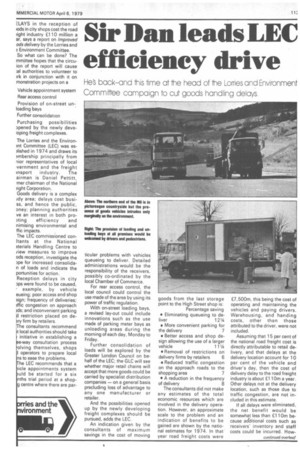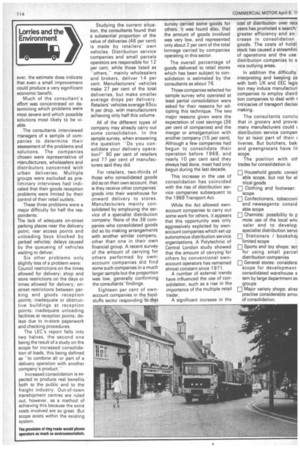Sir Dan leads LEC efficiency drive
Page 115

Page 116

If you've noticed an error in this article please click here to report it so we can fix it.
He back-and nis time at the head of the Lorries and Environment Committee campaign to cut goods handling delays.
ELAYS in the reception of ■ ods in city shops cost the road ight industry £110 million a ar, says a report on Improved ods delivery by the Lorries and ?. Environment Committee.
So what can be done? The mmittee hopes that the circuion of the report will cause :al authorities to volunteer to )rk in conjunction with it on monstration projects on a Vehicle appointment system Rear access control Provision of on-street unloading bays Further consolidation Purchasing possibilities Dpened by the newly deveoping freight complexes.
The Lorries and the Environmt Committee (LEC) was es)1ished in 1974 and draws its mbership principally from iior representatives of local vernment and the freight insport industry. The airman is Daniel Pettitt, mer chairman of the National ight Corporation.
Goods delivery is a complex Jdy area; delays cost busiss, and hence the public, Dney; planning authorities ve an interest in both pro )ting efficiency and nimising environmental and ffic impacts.
The LEC commissioned conRants at the National )terials Handling Centre to riew measures to improve ods reception, investigate the )pe for increased consolidan of loads and indicate the portunities for action.
Reception delays in city Dps were found to be caused, example, by vehicle eueing, poor access and shop sign; frequency of deliveries; iffic congestion on approach ids; and inconvenient parking cl restriction placed on de?ry firm by retailers.
The consultants recommend t local authorities should take initiative in establishing a e-way consultation process olving themselves, shops operators to prepare local ns to ease the problems.
he LEC recommends that a icle appointments system uld be started for a six nths trial period at a shopg centre where there are par ticular problems with vehicles queueing to deliver. Detailed administrations would be the responsibility of the receivers, possibly co-ordinated by the local Chamber of Commerce.
For rear access control, the local council could control the use made of the area by using its power of traffic regulation.
With on-street loading bays, a revised lay-out could include innovations such as the use made of parking meter bays as unloading areas during the morning of each day. Monday to Friday.
Further consolidation of loads will be explored by the Greater London Council on behalf of the LEC; the GLC will see whether major retail chains will accept that more goods could be carried by specialist distribution companies — on a general basis precluding loss of advantage to any one manufacturer or retailer.
And the possibilities opened up by the newly developing freight complexes should be pursued, adds the LEC.
An indication given by the consultants of maximum savings in the cost of moving goods from the last storage point to the High Street shop is: Percentage saving • Eliminating queueing to de
liver 121/4
• More convenient parking for the delivery 7
• Better access and shop design allowing the use of a larger vehicle 111/4
• Removal of restrictions on delivery firms by retailers 6 • Reduced traffic congestion on the approach roads to the shopping area 7 • A reduction in the frequency of delivery 8 The consultants did not make any estimates of the total economic resources which are involved in the delivery operation. However, an approximate scale to the problem and an indication of benefits to be gained are shown by the national estimates for 1974. In that year road freight costs were E7,500m, this being the cost of operating and maintaining the vehicles and paying drivers. Warehousing, and handing costs, other than those attributed to the driver, were not included.
Assuming that 15 per cent of the national road freight cost is directly attributable to retail delivery, and that delays at the delivery location account for 10 per cent of the vehicle and driver's day, then the cost of delivery delay to the road freight industry is about El 10m a year. Other delays not at the delivery location, such as those due to traffic congestion, are not included in this estimate.
If all delays were eliminated, the net benefit would be somewhat less than El 10m because additional costs such as receivers' inventory and staff costs could be incurred. How ever, the estimate does indicate that even a small improvement could produce a very significant economic benefit.
Much of the consultant's effort was concentrated on determining which problems were most severe and which possible solutions most likely to be viable.
The consultants interviewed managers of a sample of companies to determine their assessment of the problems and solutions. The companies chosen were representative of manufacturers, wholesalers and distributors concerned with urban deliveries. Multiple groups were excluded as preliminary interviews had indicated that their goods reception problems were limited by their control of their retail outlets.
These three problems were a major difficulty for half the respondents: The lack of adequate on-street parking places near the delivery point; rear access points and unloading bays blocked by parked vehicles; delays caused by the queueing of vehicles waiting to deliver.
Six other problems only slightly less of a problem were: Council restrictions on the times allowed for delivery; shop and store restrictions on the days or times allowed for delivery; onstreet restrictions between parking and goods reception points; inadequate or obstructive buildings at reception points; inadequate unloading facilities at reception points; delays due to in-store paperwork and checking procedures.
The LEC's report falls into two halves, the second one being the result of a study on the scope for increased consolidation of loads, this being defined as "to combine all or part of a delivery operation with another company's product."
Increased consolidation is expected to produce real benefits both to the public and to the freight industry. Out-of-town transhipment centres are ruled out, however, as a method of achieving this because the extra costs involved are so great. But scope exists within the existing system. Studying the current situation, the consultants found that a substantial proportion of the value of deliveries (46 per cent) is made by retailers' own vehicles. Distribution service companies and small parcels operators are responsible for 12 per cent, while those listed as "others," mainly wholesalers and brokers, deliver 14 per cent. Manufacturers' vehicles make 27 per cent of the total deliveries, but make smaller average drops per delivery. Retailers' vehicles average 65cu ft per drop, with manufacturers achieving only half this volume.
All of the different types of company may already carry out some consolidation. In the sample survey, when answering the question "Do you consolidate your delivery operation?" 90 per cent of retailers and 77 per cent of manufacturers said they did.
For retailers, two-thirds of those who consolidated goods did so on their own account, that is they receive other companies' goods into their warehouse for onward delivery to stores. Manufacturers mainly consolidated by employing the service of a specialist distribution company. None of the 38 companies who consolidated goods did so by making arrangements with another similar company, other than one in their own financial group. A recent survey of the amount of carrying for others performed by ownaccount companies did find some such companies in a much larger sample but the proportion was low, generally confirming the consultants' findings.
Eighteen per cent of ownaccount companies in the foodstuffs sector responding to that
survey carried some goods for others. It was found also, that the amount of goods involved was very low, and represented only about 2 per cent of the total tonnage carried by companies operating in this sector.
The overall percentage of goods delivered to retail stores which has been subject to consolidation is estimated by the consultants as about 76.
Those companies selected for sample survey who operated at least partial consolidation were asked for their reasons for adlooting this technique. The two major reasons given were the expectation of cost savings (36 per cent of companies) and the merger or amalgamation with another company (15 per cent). Although a few companies had begun to consolidate their operation before 1968, and nearly 10 per cent said they always had done, most had only begun during the last decade.
This increase in the use of consolidation has coincided with the rise of distribution service companies subsequent to the 1968 Transport Act.
While the Act allowed ownaccount companies to carry out some work for others, it appears that this opportunity was only aggressively exploited by ownaccount companies which set up autonomous distribution service organisations. A Polytechnic of Central London study showed that the amount of carrying• for others by conventional ownaccount operators has remained almost constant since 1971.
A number of external trends have influenced the use of consolidation, such as a rise in the importance of the multiple retail trader.
A significant increase in the cost of distribution over rec( years has promoted a search greater efficiency and an crease in consolidation goods. The costs of holdi stock has caused a streamlini of operations and the use distribution companies to s vice outlying areas.
In addition the difficulty interpreting and keeping pe with both UK and EEC legis tion may induce manufacturi companies to employ distrit tion companies to deal with I intricacies of transport decisi( making.
The consultants conclu that in grocery and pray's' .many manufacturers could distribution service compan for at least part of their ( liveries. But butchers, bak and greengrocers have lit scope.
The position with oth trades for consolidation is: ▪ Household goods: consic able scope, but not for el trical goods EJ Clothing and footwear: scope • Confectioners, tobacconi and newsagents: consid able scope El Chemists: possibility to p mote use of the local whc saler and to develop specialist distribution servii ▪ Stationers / bookshoj limited scope D Sports and toy shops: scc for using small parcel distribution companies E General stores: considera scope for development consolidated warehouse s tern by large department sti groups • Major variety shops: alree practise considerable amoi of consolidation.




































































































































































